
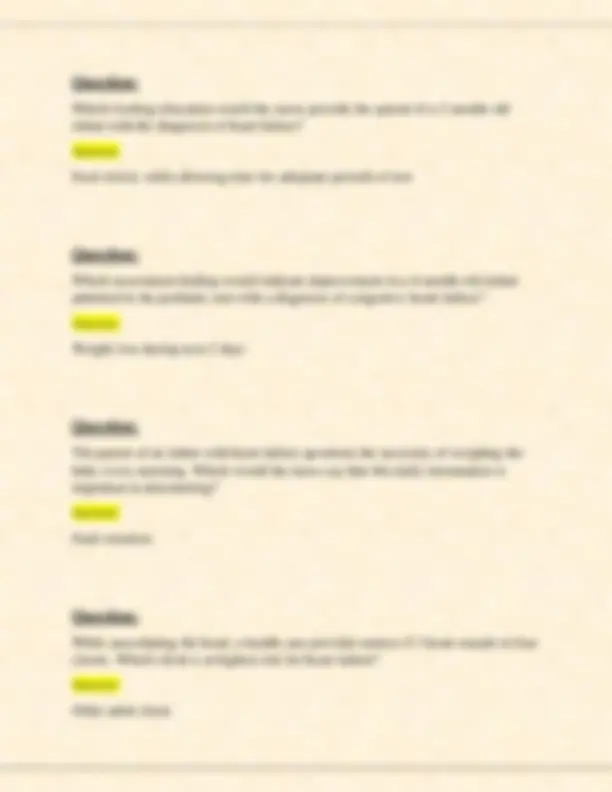

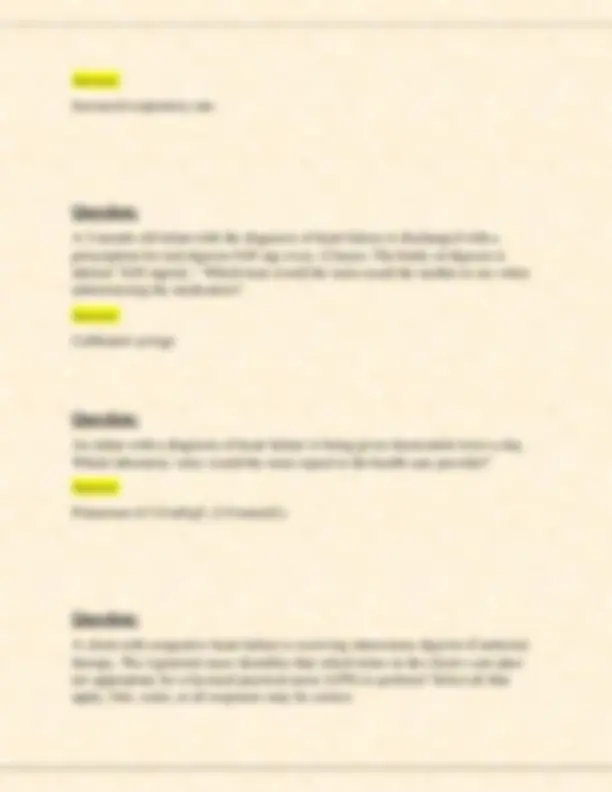
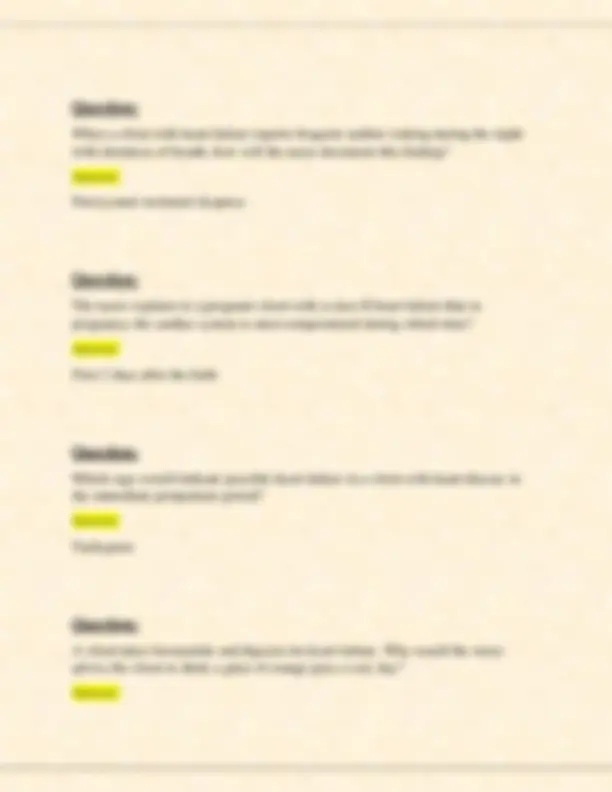
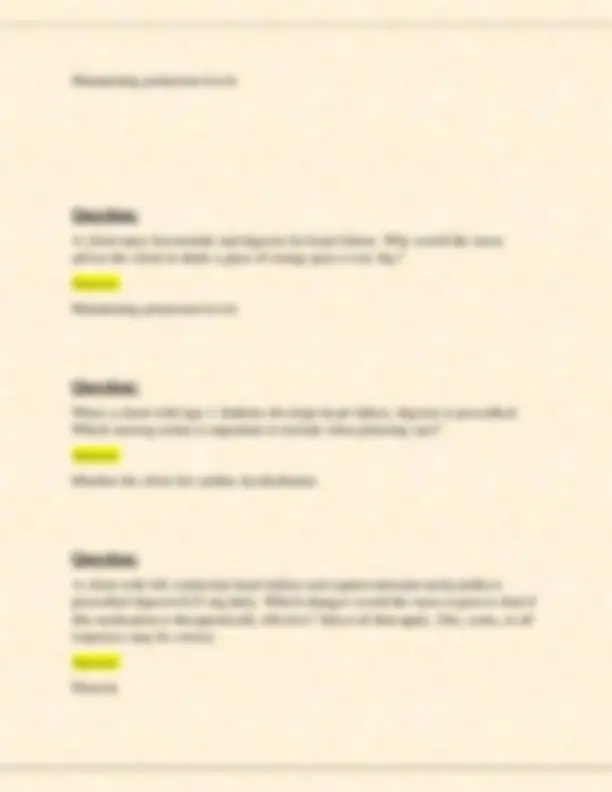
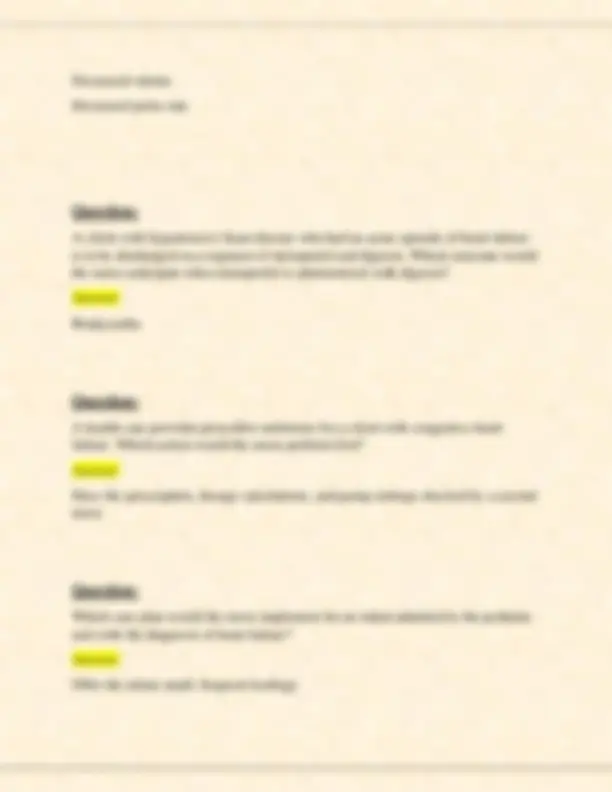
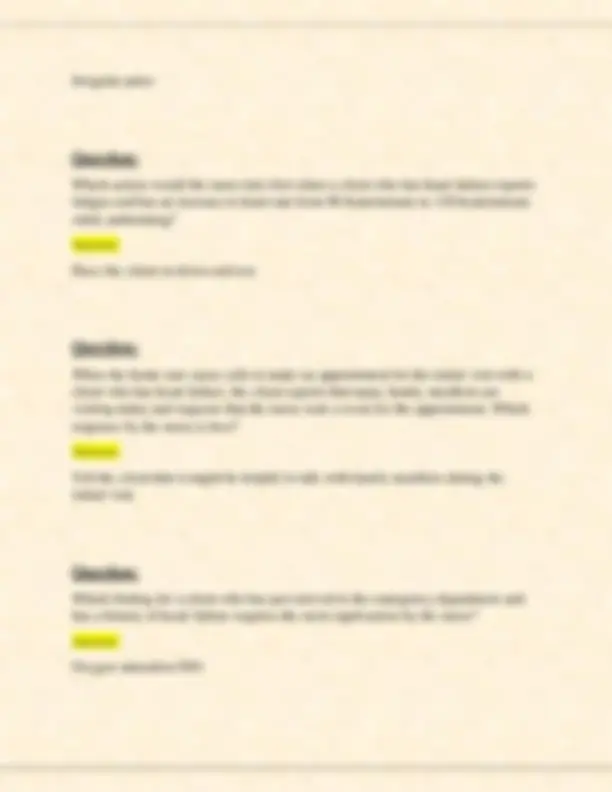
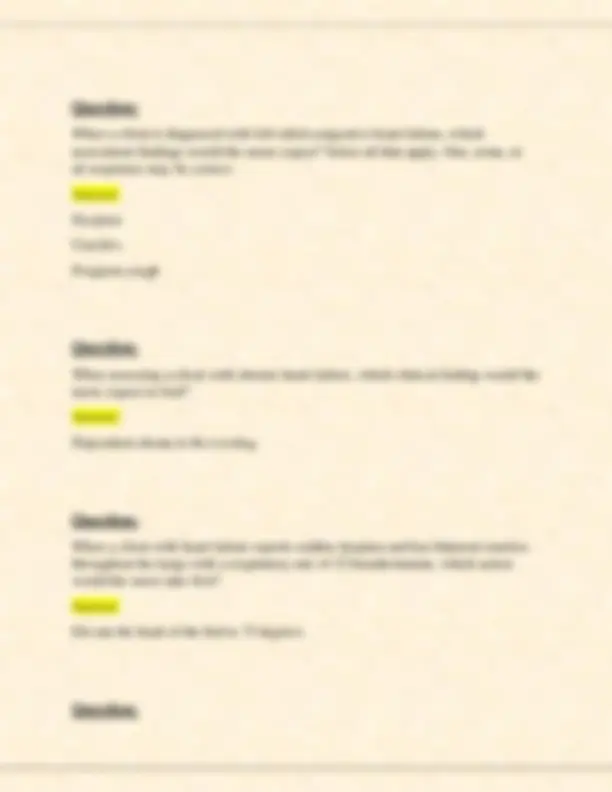
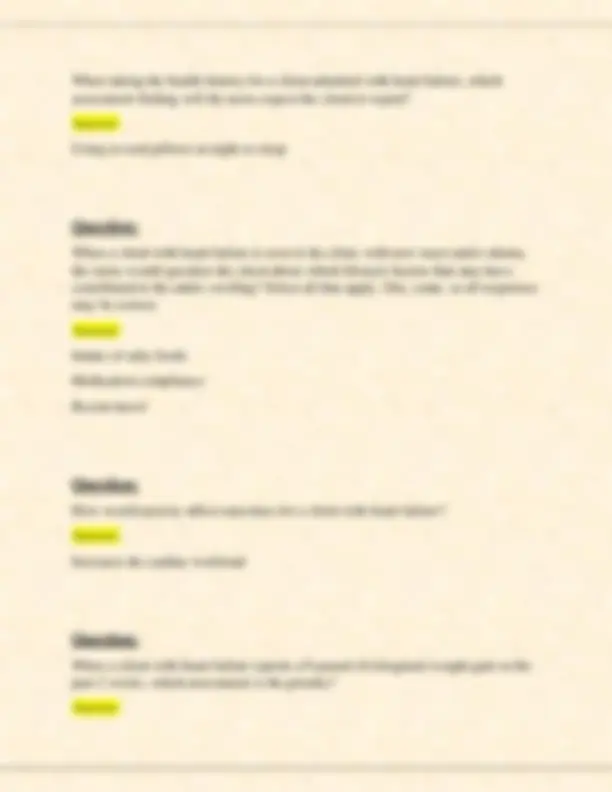
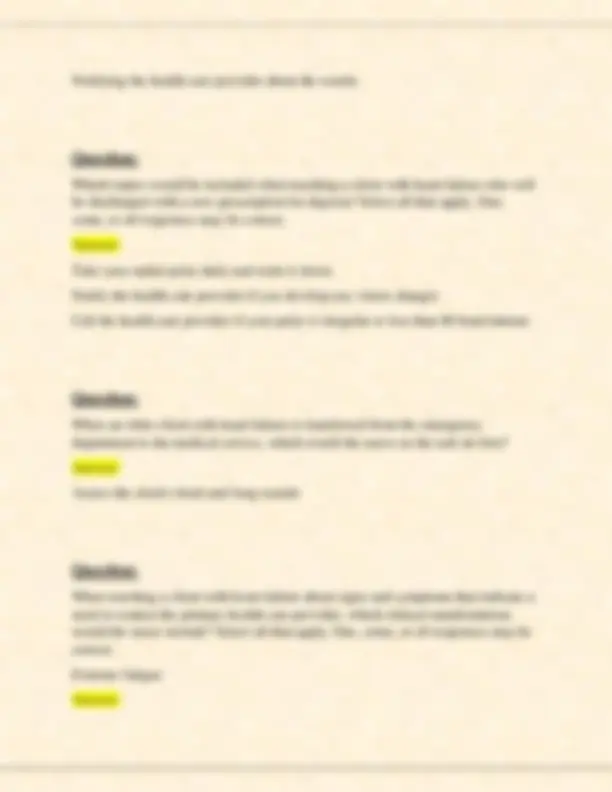
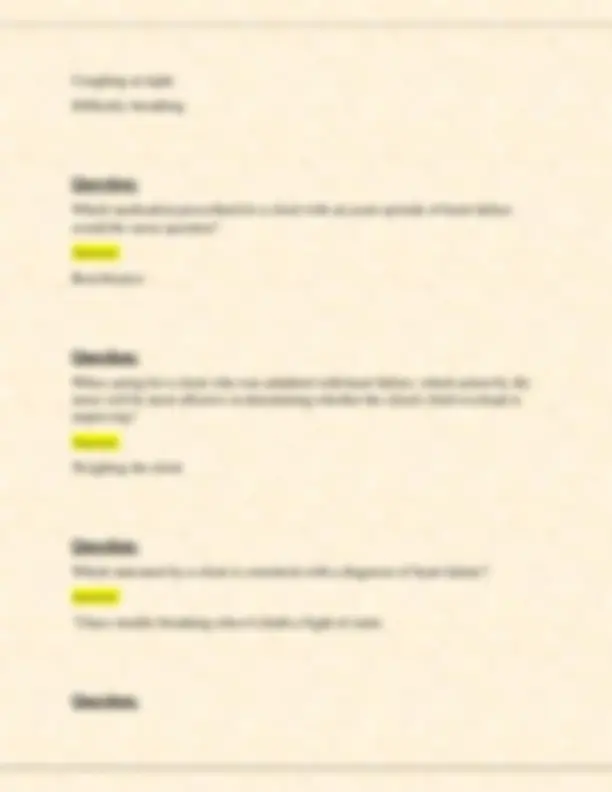
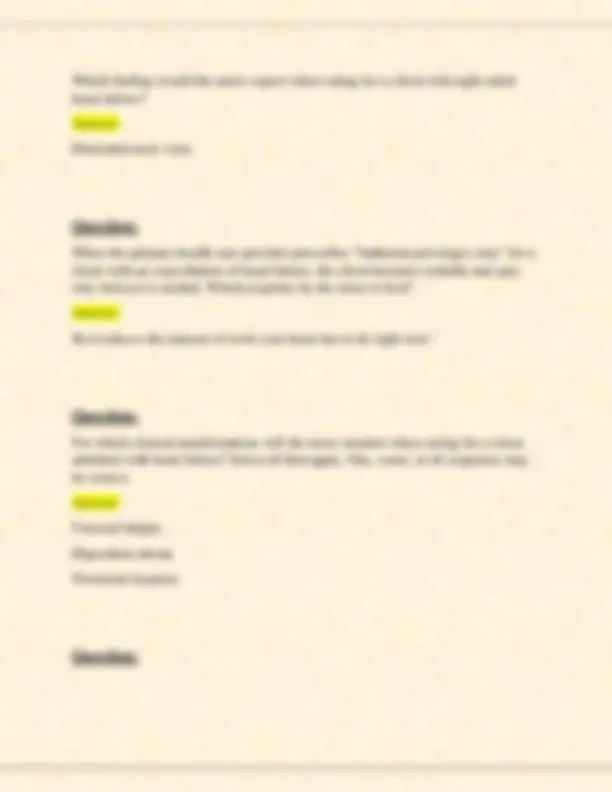
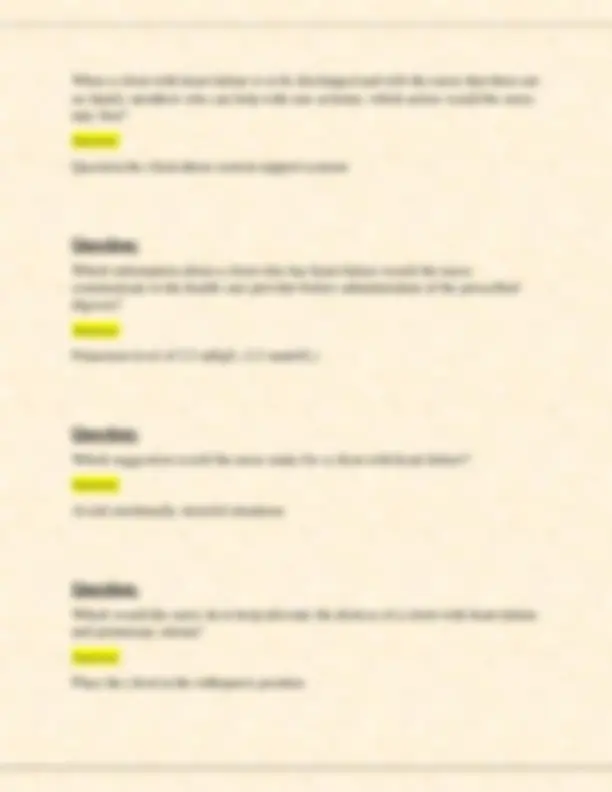
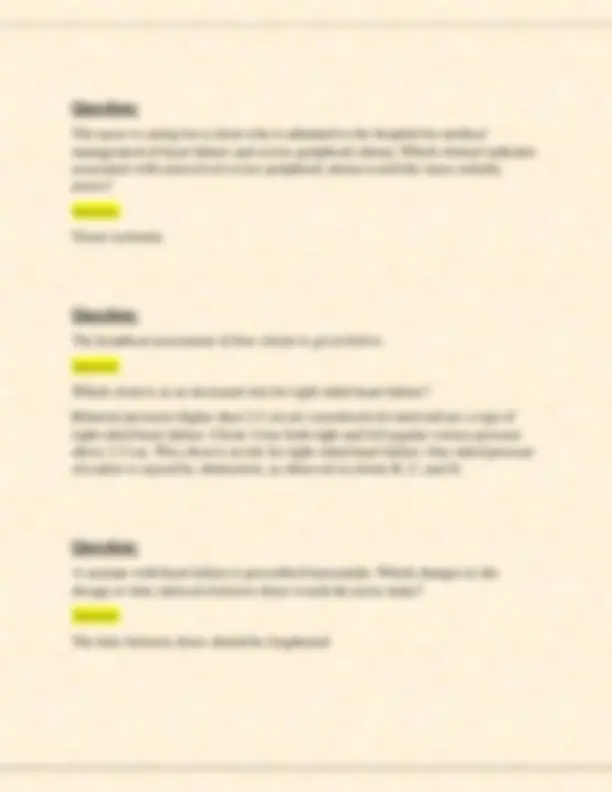
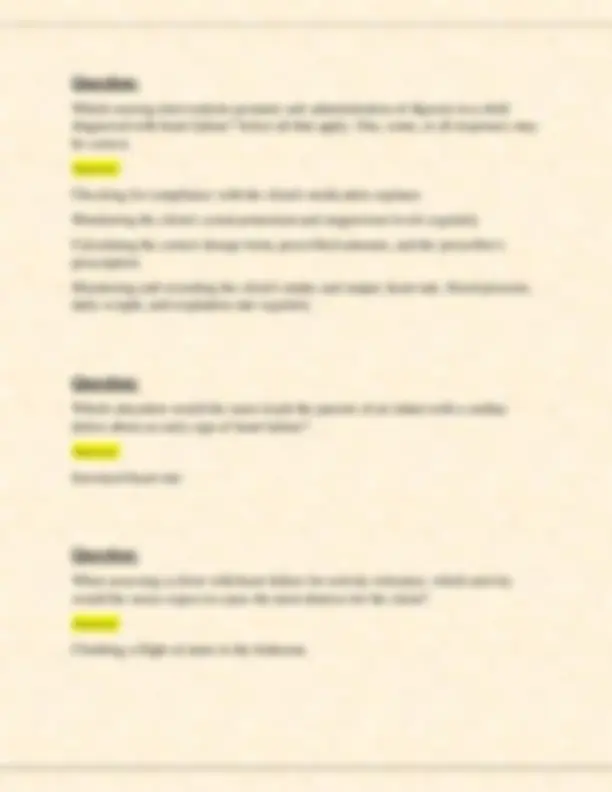
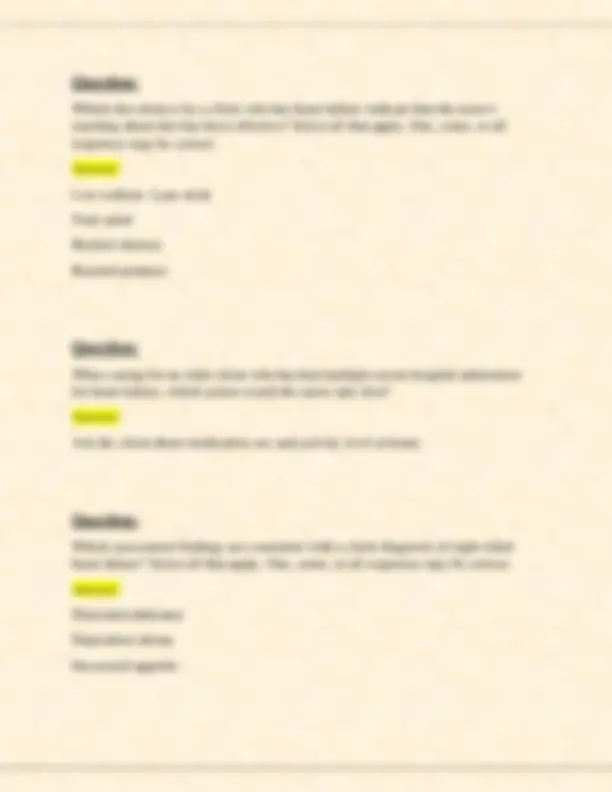
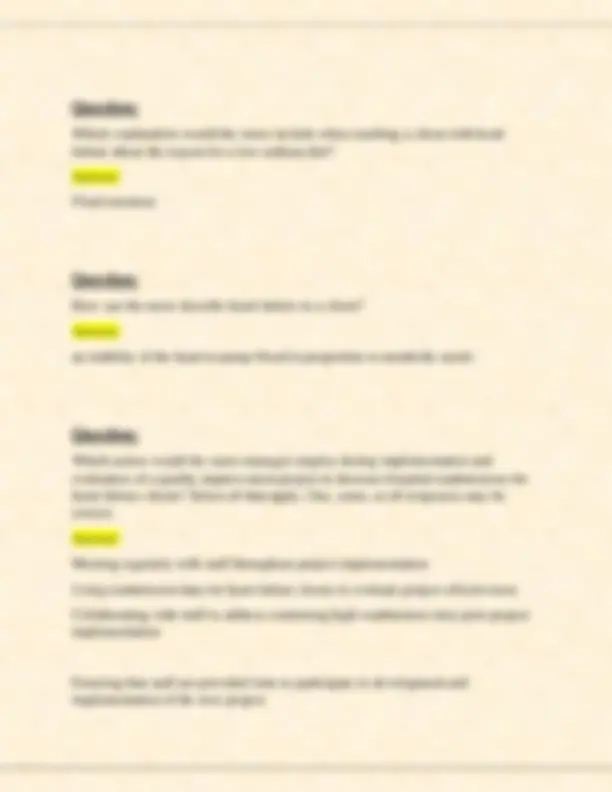
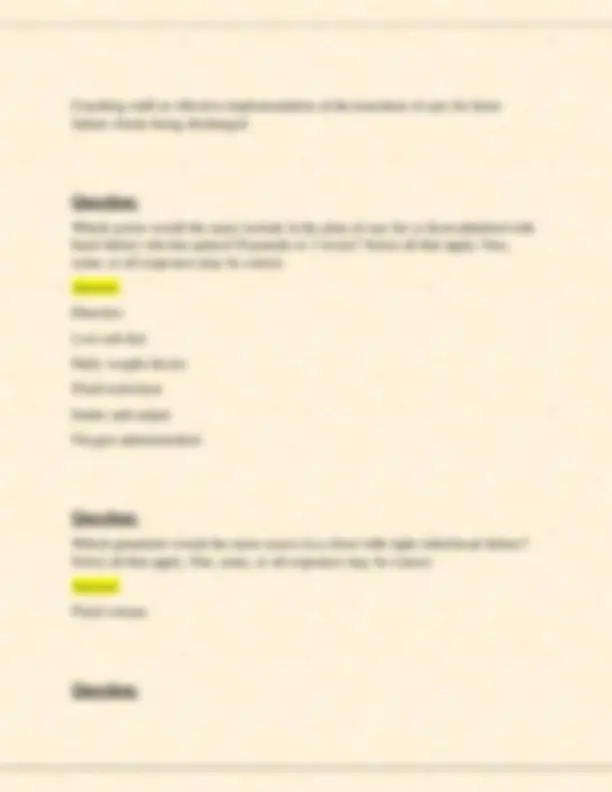
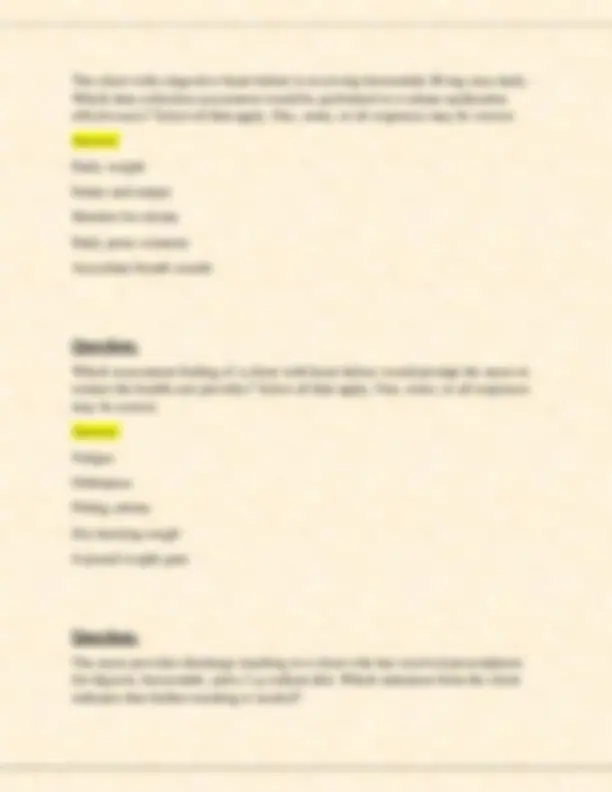
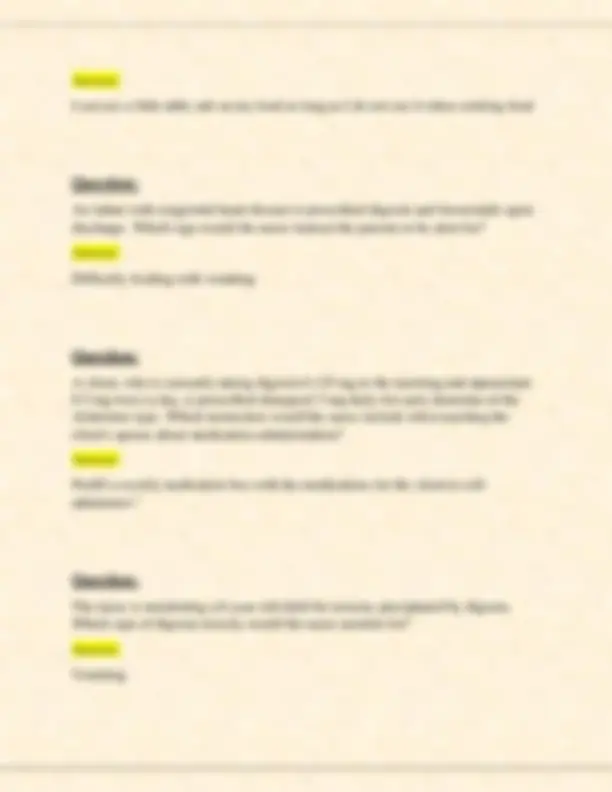
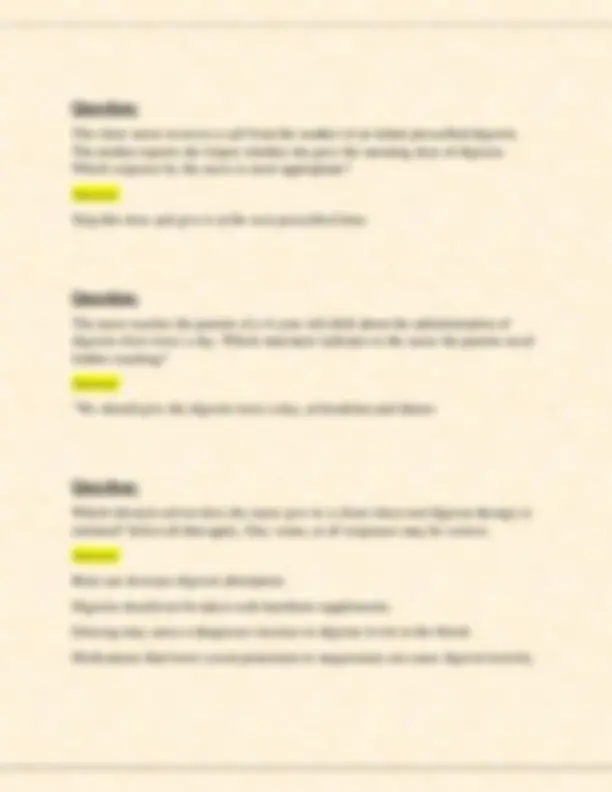
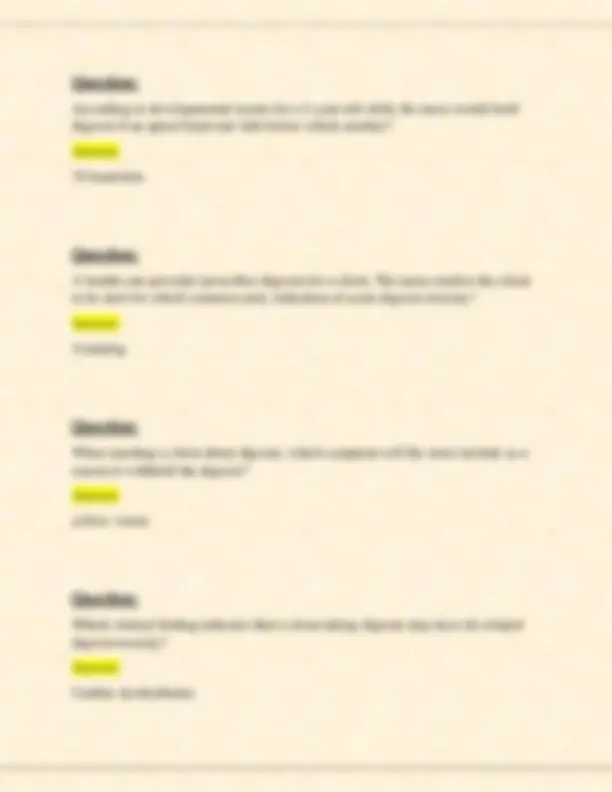
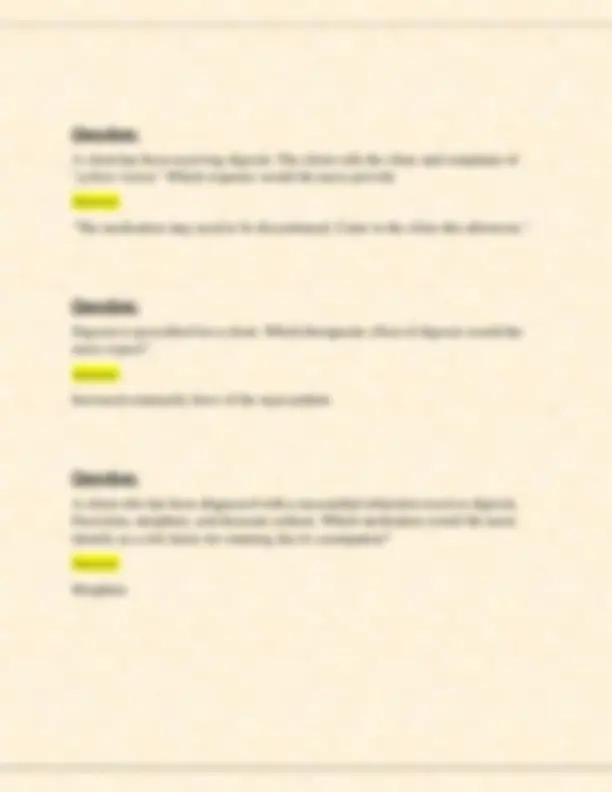


Study with the several resources on Docsity

Earn points by helping other students or get them with a premium plan


Prepare for your exams
Study with the several resources on Docsity

Earn points to download
Earn points by helping other students or get them with a premium plan
Community
Ask the community for help and clear up your study doubts
Discover the best universities in your country according to Docsity users
Free resources
Download our free guides on studying techniques, anxiety management strategies, and thesis advice from Docsity tutors
Exam 3 v1: NUR242/ NUR 242 | Question and Answers| Latest 2025/ 2026 Update | Medical – Surgical Nursing Concepts | 100% Verified Solutions | GRADED A - Galen
Typology: Exams
1 / 31

This page cannot be seen from the preview
Don't miss anything!
























An older client with a history of congestive heart failure expresses concern about potential exposure to tuberculosis (TB) from his or her roommate at the extended care facility. The roommate coughs a great deal and sometimes spits up blood. Which is the primary reason that the nurse pursues more information about the roommate? Answer: TB adversely affects older adults with chronic illness
When the clinic nurse is teaching a group of clients with heart failure (HF) about dietary interventions to prevent fluid overload, which topic will be included? Answer: Use of fresh or frozen vegetables instead of canned ones / low sodium
Which action would the nurse take first when a client with heart failure has an episode of paroxysmal nocturnal dyspnea (PND)? Answer: Assist the client to sit on the edge of the bed
When caring for a client with a diagnosis of right ventricular heart failure, the nurse expects which assessment findings? Select all that apply. One, some, or all responses may be correct. Answer: Dependent edema Swollen hands and fingers Right upper quadrant discomfort
The nurse's physical assessment of a client with heart failure reveals tachypnea and bilateral crackles. Which is the priority nursing intervention? Answer: Place client in a high-Fowler position.
Which treatment would the nurse anticipate when caring for an infant with heart failure? Answer: Medications that are prescribed for both children and adults
Which assessment finding is a late sign of heart failure? Answer: Peripheral edema
Heart failure develops in a 4-month-old infant with a congenital heart defect, and the infant exhibits marked dyspnea at rest. Which assessment finding would the nurse expect in this infant? Answer: Bilateral crackles
Which method would the nurse use to weigh a 2 - month-old in heart failure with practitioner orders for semi-Fowler positioning? Answer: Placing the infant in an infant seat, recording the weight, and then subtracting the weight of the seat
Which early sign of heart failure would the nurse recognize in an infant who has a congenital heart defect with left-to-right shunting of blood?
Answer: Increased respiratory rate
A 2-month-old infant with the diagnosis of heart failure is discharged with a prescription for oral digoxin 0.05 mg every 12 hours. The bottle of digoxin is labeled "0.05 mg/mL." Which item would the nurse teach the mother to use when administering the medication? Answer: Calibrated syringe
An infant with a diagnosis of heart failure is being given furosemide twice a day. Which laboratory value would the nurse report to the health care provider? Answer: Potassium of 3.0 mEq/L (3.0 mmol/L)
A client with congestive heart failure is receiving intravenous digoxin (Cardoxin) therapy. The registered nurse identifies that which items on the client's care plan are appropriate for a licensed practical nurse (LPN) to perform? Select all that apply. One, some, or all responses may be correct.
Answer: 2700 ml
An infant with a congenital heart defect is in heart failure and is receiving daily weight measurements. Which complication of heart failure would daily weights help monitor? Answer: Fluid retention
Which intervention would the nurse implement for a 4-month-old infant with tetralogy of Fallot and heart failure? Answer: Providing small, frequent feedings
The nurse provides teaching to a client who is being discharged after an acute exacerbation of chronic obstructive pulmonary disease (COPD). The nurse would instruct the client to monitor for which indication of right-sided heart failure? Answer: Weight gain
When a client with heart failure reports frequent sudden waking during the night with shortness of breath, how will the nurse document this finding? Answer: Paroxysmal nocturnal dyspnea
The nurse explains to a pregnant client with a class II heart failure that in pregnancy the cardiac system is most compromised during which time? Answer: First 2 days after the birth
Which sign would indicate possible heart failure in a client with heart disease in the immediate postpartum period? Answer: Tachypnea
A client takes furosemide and digoxin for heart failure. Why would the nurse advise the client to drink a glass of orange juice every day? Answer:
Decreased edema Decreased pulse rate
A client with hypertensive heart disease who had an acute episode of heart failure is to be discharged on a regimen of metoprolol and digoxin. Which outcome would the nurse anticipate when metoprolol is administered with digoxin? Answer: Bradycardia
A health care provider prescribes milrinone for a client with congestive heart failure. Which action would the nurse perform first? Answer: Have the prescription, dosage calculations, and pump settings checked by a second nurse
Which care plan would the nurse implement for an infant admitted to the pediatric unit with the diagnosis of heart failure? Answer: Offer the infant small, frequent feedings
Which parent education would the nurse provide as rationale for gavage feedings in an infant with congestive heart failure? Answer: The energy that would have been expended on suckling is conserved
Which assessment finding for a client with heart failure who is taking digoxin will be most important to communicate to the health care provider? Answer: Premature ventricular contractions
Which statement made by the nursing student requires correction regarding the effect of applying the Roy adaptation model on improved functional status in clients with heart failure? Answer: Use of literature resources supports practical-based nursing interventions."
The nurse assesses bilateral +4 peripheral edema while assessing a client with heart failure and peripheral vascular disease. Which is the pathophysiological reason for the excessive edema?
Irregular pulse
Which action would the nurse take first when a client who has heart failure reports fatigue and has an increase in heart rate from 90 beats/minute to 120 beats/minute while ambulating? Answer: Have the client sit down and rest
When the home care nurse calls to make an appointment for the initial visit with a client who has heart failure, the client reports that many family members are visiting today and requests that the nurse wait a week for the appointment. Which response by the nurse is best? Answer: Tell the client that it might be helpful to talk with family members during the initial visit.
Which finding for a client who has just arrived in the emergency department and has a history of heart failure requires the most rapid action by the nurse? Answer: Oxygen saturation 86%
When a client is diagnosed with left-sided congestive heart failure, which assessment findings would the nurse expect? Select all that apply. One, some, or all responses may be correct. Answer: Dyspnea Crackles Frequent cough
When assessing a client with chronic heart failure, which clinical finding would the nurse expect to find? Answer: Dependent edema in the evening
When a client with heart failure reports sudden dyspnea and has bilateral crackles throughout the lungs with a respiratory rate of 32 breaths/minute, which action would the nurse take first? Answer: Elevate the head of the bed to 75 degrees.
Auscultate breath sounds.
Which statement by a client who is seen for follow-up in the heart failure clinic is most important for the nurse to communicate to the health care provider? Answer: "I wake up at night short of breath"
A client with heart failure reports waking suddenly and feeling short of breath during the night. How will the nurse document this information? Answer: Paroxysmal nocturnal dyspnea
When a client with a history of heart failure on daily weights has a 4-pound (1.8- kilogram) weight gain since the previous day, which action would the nurse take next? Perform a head-to-toe assessment. Answer:
When caring for a client who has heart failure, with blood pressure 102/70 mm Hg, pulse 106 beats/minute, and bilateral lung crackles, which prescribed action would the nurse question? Answer: Infuse normal saline at 100 mL/h
When a client with a history of heart failure arrives for a scheduled clinic appointment and has gained 6 lb (2.7 kg), which nursing action has the highest priority? Answer: Listen to the client's breath sounds
When caring for a client with heart failure, which type of lung sounds would the nurse expect to hear? Answer: Crackles
When reviewing laboratory results for a client with heart failure who has been receiving furosemide daily, the nurse notes a blood urea nitrogen (BUN) of 42 mg/dL (15.2 mmol/L) and a creatinine of 1.1 mg/dL (97 mcmol/L). Which action by the nurse is a priority? Answer:
Coughing at night Difficulty breathing
Which medication prescribed for a client with an acute episode of heart failure would the nurse question? Answer: Beta blocker
When caring for a client who was admitted with heart failure, which action by the nurse will be most effective in determining whether the client's fluid overload is improving? Answer: Weighing the client
Which statement by a client is consistent with a diagnosis of heart failure? Answer: "I have trouble breathing when I climb a flight of stairs.
Which finding would the nurse expect when caring for a client with right-sided heart failure? Answer: Distended neck veins
When the primary health care provider prescribes "bathroom privileges only" for a client with an exacerbation of heart failure, the client becomes irritable and asks why bed rest is needed. Which response by the nurse is best? Answer: Rest reduces the amount of work your heart has to do right now."
For which clinical manifestations will the nurse monitor when caring for a client admitted with heart failure? Select all that apply. One, some, or all responses may be correct. Answer: Unusual fatigue Dependent edema Nocturnal dyspnea